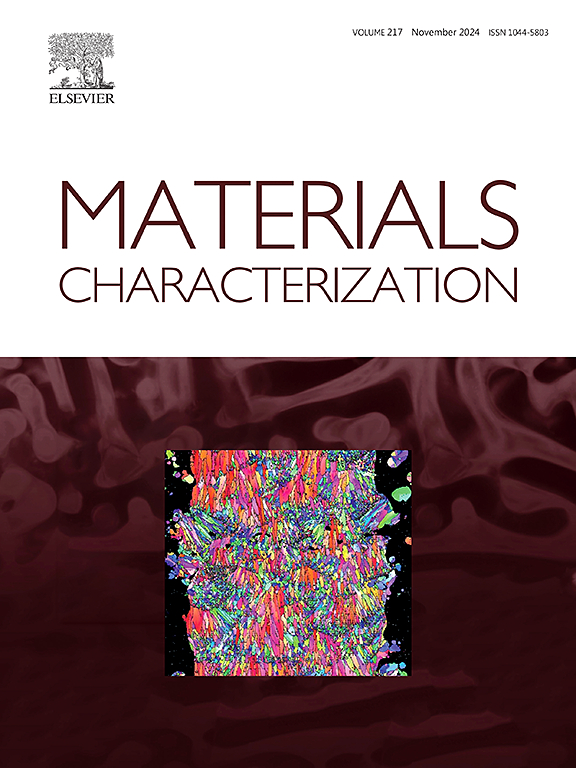Developing advanced high strength Ni-Cr-Mo-V steels with a superlative strength-elongation-toughness synergy through different processing routes
IF 4.8
2区 材料科学
Q1 MATERIALS SCIENCE, CHARACTERIZATION & TESTING
引用次数: 0
Abstract
This article addresses advanced high-strength Ni-Cr-Mo-V steels developed by different processing routes. First, three preliminary microstructures containing ferrite-pearlite, ferrite-martensite, and fully martensitic were made. These microstructures were also subjected to the cold-rolling with a 25 % thickness reduction. Ultimately, intercritical treatment (IT) was performed on non-deformed and deformed preliminary microstructures at a given temperature and time. The phase characterization through optical microscopy (OM), field emission scanning electron microscopy (FE-SEM), and electron backscattered diffraction (EBSD) revealed a fine-tuned microstructure in the intercritically treated steel with non-deformed fully martensitic preliminary microstructure. There were lath-like ferrite with a finer size, lath-like new martensite, tempered martensite, higher geometrically necessary dislocations (GNDs) density, and a higher fraction of coincident site lattice boundaries (CSLBs) in this steel. Such formed microstructure could well tailor mechanical performance and lead to achieving the best strength-elongation-toughness synergy. At this condition, yield strength, ultimate tensile strength, elongation, tensile toughness, and Charpy impact energy were 1205±31 MPa, 1366±33 MPa, 13.1±1.0 %, 168.4±11.0 MJ/m3, and 83±5 J, respectively. It was found that the steel with a cold-rolled fully martensitic microstructure consisted of a complex microstructure after IT among the intercritically treated steels with deformed preliminary microstructures. Ultra-fine ferrite with lath and polygonal morphologies, lath-like martensite, blocky-like martensite, higher GNDs density, and more fraction of CSLBs were detected in this steel. Such a complex microstructure attained extraordinary strength-elongation-toughness synergy. Yield strength, ultimate tensile strength, elongation, tensile toughness, and Charpy impact energy equaled 1175±19 MPa, 1402±25 MPa, 11.7±0.4 %, 150.8±13.0 MJ/m3, and 102±2 J, respectively. Dimple and cleavage features were observed in the fracture surfaces of all intercritically treated steels after performing uniaxial tensile and Charpy impact tests at the room temperature. Failure and toughening mechanisms were comprehensively discussed, as well.
通过不同的加工工艺开发具有超强强度-伸长-韧性协同作用的先进高强度镍铬钼钒钢
本文论述了通过不同加工工艺开发的先进高强度镍铬钼钒钢。首先,制作了包含铁素体-珠光体、铁素体-马氏体和全马氏体的三种初步微结构。这些微观结构还经过了厚度减少 25% 的冷轧处理。最后,在给定的温度和时间下,对非变形和变形的初步微结构进行临界间处理(IT)。通过光学显微镜(OM)、场发射扫描电子显微镜(FE-SEM)和电子反向散射衍射(EBSD)进行的相表征显示,经间歇处理的钢材具有微调的微观结构,其初始微观结构为非变形全马氏体。这种钢中存在尺寸更小的板状铁素体、板状新马氏体、回火马氏体、更高的几何必要位错(GNDs)密度以及更高比例的∑3共点晶格边界(CSLBs)。这样形成的微观结构可以很好地调整机械性能,从而实现最佳的强度-伸长-韧性协同效应。在此条件下,屈服强度、极限抗拉强度、伸长率、拉伸韧度和夏比冲击能分别为 1205±31 MPa、1366±33 MPa、13.1±1.0 %、168.4±11.0 MJ/m3 和 83±5 J。研究发现,冷轧完全马氏体显微组织的钢材在经过间歇处理后具有复杂的显微组织,初步显微组织为变形。在这种钢中检测到了板条状和多边形形态的超细铁素体、板条状马氏体、块状马氏体、较高的 GNDs 密度和较多的∑3 CSLBs。这种复杂的微观结构实现了非凡的强度-伸长-韧性协同作用。屈服强度、极限抗拉强度、延伸率、拉伸韧度和夏比冲击能分别为 1175±19 MPa、1402±25 MPa、11.7±0.4 %、150.8±13.0 MJ/m3 和 102±2 J。在室温下进行单轴拉伸和夏比冲击试验后,所有经过中间处理的钢材断裂表面都出现了凹陷和劈裂特征。此外,还全面讨论了断裂和增韧机制。
本文章由计算机程序翻译,如有差异,请以英文原文为准。
求助全文
约1分钟内获得全文
求助全文
来源期刊

Materials Characterization
工程技术-材料科学:表征与测试
CiteScore
7.60
自引率
8.50%
发文量
746
审稿时长
36 days
期刊介绍:
Materials Characterization features original articles and state-of-the-art reviews on theoretical and practical aspects of the structure and behaviour of materials.
The Journal focuses on all characterization techniques, including all forms of microscopy (light, electron, acoustic, etc.,) and analysis (especially microanalysis and surface analytical techniques). Developments in both this wide range of techniques and their application to the quantification of the microstructure of materials are essential facets of the Journal.
The Journal provides the Materials Scientist/Engineer with up-to-date information on many types of materials with an underlying theme of explaining the behavior of materials using novel approaches. Materials covered by the journal include:
Metals & Alloys
Ceramics
Nanomaterials
Biomedical materials
Optical materials
Composites
Natural Materials.
 求助内容:
求助内容: 应助结果提醒方式:
应助结果提醒方式:


